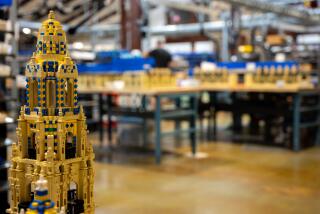It may look like fun and games, but it’s a tough living. The odds are against them, but somehow that doesn’t stop . . . : Inventors in Toyland
Sitting in his swanky Santa Monica condo, David Fuhrer cracks a schoolboy grin and makes a curt confession that few other 32-year-olds could fathom:
“These toys, they’ve taken over my life.” Well, they’re not all toys--not yet, anyway. Some are skeletons of toys, husks of toys and toy guts such as half-finished robot arms, hollowed-out noisemaking footballs, eyeball-less monster faces and bald pencils that haven’t grown their hair yet.
Indeed, like a scene from “The Twilight Zone,” the gizmos, gadgets and thingamajigs have taken command of Fuhrer’s bedroom, his kitchen, even his bathroom--consuming his dreams and waking hours.
Toys, toys, toys. Hanging from shelves, poking from cluttered cardboard boxes, staring out from walls. Round-the-clock, novelty concepts are being dreamed up, drawn up and brought to life in the mind’s-eye of the New York-born son of a toy industry executive--a modern-day Geppetto with a dash of California camp.
Some of Fuhrer’s ideas are truly off-the-wall. Like a child with a new plaything, he picks up a clear plastic breast implant from the sea of toy parts on his desk, rolling the soft glob, Slinky-like, in his hands.
“This is my next project,” he says with a wild-eyed smile. “I’ve just got to find a way to make something fun out of this stuff. It’s got such . . . possibility!”
Brace yourself for this: Santa does not make toys. They’re born in the workshops of inventors like Fuhrer--a strange, lunatic-fringe mixture of playfully mad pop-culture scientist and savvy, bottom-line businessman.
In cluttered garages, sheds and cellars, from Santa Monica to Syracuse, hundreds of obsessed inventors scheme to create the newest madcap novelty--the next Whoopee cushion, Hula-Hoop, Nerf ball, Silly Putty, Rubik’s Cube, Mr. Potato Head, Yo-Yo or--whew!--dancing Coca-Cola can.
They’re people like Rob Angel, a former Seattle waiter who, along with two partners, made millions by devising the board game Pictionary. Or Eddy Goldfarb, a pioneering 71-year-old San Fernando Valley inventor.
During World War II, Goldfarb saw a magazine ad for a special glass to hold dentures and laughed so hard, he got the idea for a novelty toy: the infamous windup chattering teeth. His idea not only sold millions but became a piece of Americana.
Such success stories, however, are rare. In the hard-edged, shark-toothed world of toys and novelties, independent creators face a 97% rejection rate--on a good day.
‘Round the clock, Fuhrer’s fax machine spits out “Don’t Call Us, We’ll Call You” brushoffs from giants such as Mattel, Hasbro and even the smaller players. He shuffles off concepts like a Vegas card dealer; overnight deliverymen know him by name.
He’s had some luck, such as his wacky board games Backwords and Motor Mouth, which sold 250,000 and 100,000 copies, respectively.
But other brainstorms bombed or misfired. Take the multiple murderer trading cards for kids: Collect ‘em! Trade ‘em! Arrest all 250 gruesome killers!
Not everyone laughed, Fuhrer sighs: “Apparently, there was this civil liability problem because there wouldn’t be any way to retrieve the cards once some killers finished doing their time. That one bugged me. I could have made millions!”
Indeed, the stakes for novelties and toys are high enough to send inventors like Fuhrer back to their drawing boards. In 1993, cash registers will jingle with toy sales of more than $13 billion. Each year, 6,000 new toys and novelties flood the U.S. market.
But dreaming up gimmicky novelties is not all fun and games.
Of 150 serious toy inventors nationwide, industry officials estimate, fewer than 50 have the potential, as one puts it, “to hit the long ball” and concoct a novelty like the Pet Rock that can change the way Americans think about worthless hunks of stone.
And, the depressed economy has hit the industry like a GI Joe attack. Some major firms have consolidated, shrinking available markets for inventors.
Each February, independent creators flock to the toy fair in New York City, hoping retail buyers from such mega-chains as Toys R Us, Spencer Gifts and Target will see their invented babies as the next Barbie.
They do the revolving-door dance with big manufacturers, hoping against hope to sell their rights.
“But every toy creator knows the abysmal odds for success,” says Ronald Weingartner, director of inventor relations at Milton-Bradley and co-author of “Inside Santa’s Workshop: How Toy Inventors Develop, Sell and Cash In on Their Ideas.”
“They know that for every 100 outside ideas a toy company receives, they’re lucky to see one get produced.”
As a result, inventors say, the industry can become a realm of spy-versus-spy secrecy.
Then there’s the lawsuits. In 1978, a New Jersey inventor sued Mattel Inc., claiming it had infringed on his patent for the snap-together plastic track parts that the company used for its Hot Wheels miniature vehicles.
This summer, a federal appeals court overturned a 1990 judgment for $24.8 million against the toy maker.
Such cases chill independent creators, turning many into suspicious, clandestine operators who jealously protect projects and who, in some cases, become neurotics convinced that a slip of the tongue could cost millions.
Inventors believe the most outrageous ideas come from the fringe, not from the carpeted recesses of big toy companies. And nobody--repeat, nobody --is going to rip off their ideas. Some rush for patents. Others hope a hot creation will sell so fast and so widely that it immediately becomes a household word and is impossible to pilfer.
“It’s a very confidential business,” Goldfarb confides. “When you get a hot item, there’s always a chance that someone could steal it. We still use paper shredders at our office.”
That security has paid off. In the 45 years since he first fashioned the chattering teeth, Goldfarb has produced more than 530 successful toy and novelty ideas, and has a staff of 11 inventors--including his son--at his Northridge offices.
Often, toy shelf-life is a nanosecond short, as many are yanked prematurely to make room for a new gadget. And even though major manufacturers host inventor conferences, it’s still a lonely world for the independent toy developer.
“It’s definitely a ‘What have you done for me lately?’ business,” says Elliot Rudell, 43, who has conceived such games as Weebles--wobbly figures for preschoolers--and Splash Out, a game that employs an exploding water balloon. “You’re on your own out there.”
Rudell, a local inventor who left Mattel in 1975, began his business in a home office where his daughter’s crib shared space with his tools.
“We have a saying among inventors that R & D in the independent toy-creating world doesn’t mean research and development. It really means royalty and decadence. Or rejection and depression,” he says. “Being an independent creator gives you time to chase dreams. The downside is that if you don’t perform, you don’t eat.”
Then there’s the inventor’s creative carrot, the high of producing a monster-selling toy.
“I’ve always felt more like a gambler than an inventor,” says Mark Setteducati, a New York City inventor who fashioned travel versions of the popular television games “Jeopardy!,” “Wheel of Fortune” and “The Dating Game” and who teaches a college course on toy and game inventing.
“Every time I sell a toy, I feel like I’m that guy who went to Vegas with a nickel and came home a millionaire. You can’t beat the rush. But money isn’t everything. Inventors want to create a novelty that will be played long after they’re dead. That’s immortality!”
Former accountant Terry Langston never dreamed such wild success would come from a dorky picture-drawing game. “At first, I hated the idea,” he says of Pictionary, which he says was derived from an old parlor game in which competitors drew pictures against the clock. “Now it’s sold worldwide--25 million games in 26 countries and 14 languages. Who would have believed?”
Not the lady in one Seattle toy store. After dreaming up Pictionary, Langston and partners Angel and Gary Everson hit the local toy outlet to drum up interest.
“(She) took one look at the game and said, ‘This is the stupidest thing I’ve ever seen! You’ll never go anywhere with it.’ Geez, I wish I had her address today.”
If most toy inventors are turncoat engineers and scientists, then David Fuhrer’s path took a weird twist: He started out as the guy who could talk backward.
In a split-second, he can memorize and repeat names, phrases and entire book pages--backward.
For Fuhrer, toy becomes yot. And crazy is, of course, yzarc.
After exposure on the David Letterman and Johnny Carson shows, as well as a page in the Guinness Book of World Records, Fuhrer decided to try to cash-in on his “strange, useless ability:” He invented a backward-talking board game.
“Backwords” and his second game, “Motor Mouth,” a tongue-twisting test invented with John Moschitta Jr., the speed talker from the old Federal Express commercials, sold worldwide.
A decade later, Fuhrer still invents, but also acts as a broker and agent for several other creators--helping to guide them through the minefield of marketing their ideas, securing an average 5% (of the wholesale price) in royalties and handling other toy industry salespeople and business-types.
This February, he’ll introduce a dozen ideas to the toy fair in New York. They’re creations like his Key Buddy--little monster-faces that attach to a child’s house keys. Or the self-warming gloves. Or the soft-bladed portable fan.
Until then, he says, he’ll forgo the corporate-style product-testing, focus groups and market surveys to stick to what he knows best: kids.
He watches Saturday morning cartoons, walks through countless stores and neighborhood malls and even stops youngsters on the street, polling their reaction to his gizmos.
Kids, he says, are the gods of toy-market research:
“They’re brutal critics because they’ll tell you exactly how they feel. If your idea is a dud, you’ll know the moment they look at it.”
More to Read
Inside the business of entertainment
The Wide Shot brings you news, analysis and insights on everything from streaming wars to production — and what it all means for the future.
You may occasionally receive promotional content from the Los Angeles Times.











